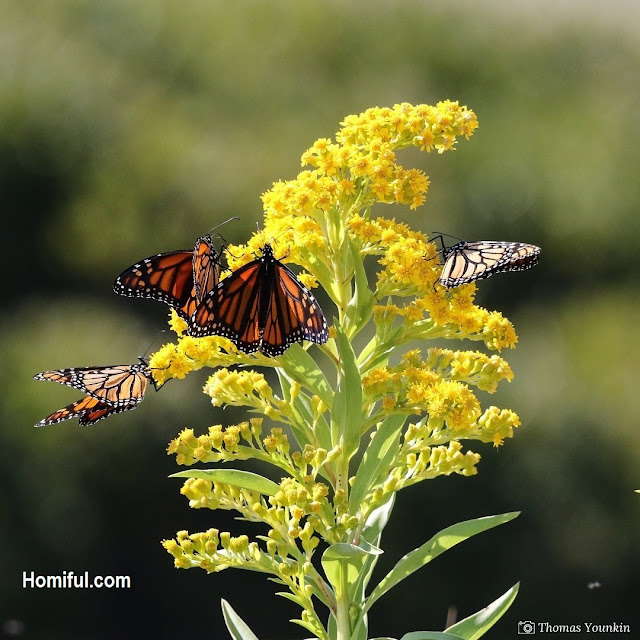 |
| 6 Plants You Might Avoid If You Have Allergies |
Homiful.com -- Are allergies or asthma keeping you from enjoying your garden? Allergies to many plant species are common, and depending on the allergy, a person may have a wide range of symptoms. Plants that rely on wind for pollination are more likely to create allergy problems since pollen is carried by the wind and comes into touch with humans.
Knowing the source of your allergy, however, will allow you to continue enjoy a lovely landscape. Perhaps this "6 Plants You Might Avoid If You Have Allergies" can give you some answers.
Daisy
 |
| @waterwiseplants |
Daisy, especially oxeye or common daisy, leucanthemum vulgare, chrysanthemum leucanthemum, could be the reason of your allergic reaction. Another ragweed cousin, the oxeye daisy, is one of the most popular summer daisies. It might also be an issue for allergy sufferers. People have allergic reactions to pollen, leaves, flowers, and even extracts derived from them, resulting in fever, rashes, hives, and other unpleasant symptoms.
Fall phlox (Phlox paniculata) is an alternative that is more allergy-friendly if you're seeking for white blooms in the summer. Its fragrant blooms bloom all summer in hues ranging from white to pink, rose, red, and lavender.
Chamomile (matricaria recutita)
 |
| @tinathelen |
Who would have thought that a herb revered for its relaxing properties could also be an allergy trigger? Chamomile pollen can add to fever symptoms, the leaves and blossoms can cause skin problems, and drinking it might be problematic if you are very sensitive.
This is due to the fact that chamomile is one of several common plants associated to ragweed, which is notorious among allergy patients. For alternatives, woolly thyme (Thymus pseudolanuginosus) is a fast-growing option for a ground cover.
Sunflower (helianthus annuus)
 |
| @photopedia_by_aopshara |
These summer blooms, sunflowers, may also be allergy triggers. Both the pollen and the seeds, like its cousins chamomile, oxeye daisy, and ragweed, can be problematic. Some people even respond when they touch or brush across the leaves. But you don't have to stop planting these cheerful flowers.
Sunflowers that are pollen-free or hypoallergenic are now available. Among the most well-known are 'Apricot Twist,' 'Infrared Mix,' 'Lemon Eclair,' 'The Joker,' 'Moonbright,' ProCut Bicolor, 'Sunbeam,' 'Sunbright Supreme,' and Sunrich.
Juniper (juniperus spp.)
 |
| @house_of_immortelle |
Many people return from a pruning session with their juniper shrubs to find that their hands are inflamed. Although this landscape classic is popular, both its pollen and touch with the plant can induce hay fever and skin problems. Look for female plants if you are determined to grow juniper even though it annoys you.
Plant rosemary (Rosmarinus officinalis) for a similar appearance but without the responses. This is a common plant in Mediterranean gardens. It's both fragrant and useful in the kitchen. It is also easily to shape and can draws hummingbirds, butterflies, and bees.
Ragweed (ambrosia spp.)
 |
| @gardenforwildlife |
Ragweed pollen can induce allergic reactions in many people. Sneezing, a runny or stuffy nose, and an itchy throat are among the symptoms. However, when it blooms in late summer and fall, it can be rather lovely. So, if you enjoy the style but don't want the allergies, there is an alternative.
Goldenrod (Solidago spp.) has been wrongly painted with the same pollen-laden brush as ragweed for years. Goldenrod pollen is now proven to be transmitted by insects, and the plant is no more likely to trigger allergies than many other plants suggested to hay fever sufferers.
Wisteria (wisteria floribunda, w. chinensis)
 |
| @bontsai_ |
No matter how much people gush about the romanticism of wisteria draped over patios and climbing up pillars in spring, if wisteria bothers your allergies, the only thing you'll be doing is avoiding the area as soon as possible. The pollen is a well-known cause of hay fever, and trimming or even touching the plant can result in skin responses.
If you want a flowering vine that will stretch over a pergola or trellis, evergreen clematis (Clematis armandii) or clematis hybrids may be the answer.
Like this article? Don't forget to share and leave your thumbs up to keep support us. Stay tuned for more interesting articles from us in the future!
For those of you looking for a minimalist home design that ranges from simple to modern. Please leave your message and comments on Home Lovers on Facebook.
This article should be useful for those of you looking for design ideas and house plans.
Hopefully, you will find it easier to create your ideal home.
Don't forget to share it with your friends and family so that it can help others.
Author : Rieka
Editor : Munawaroh
Source : Various sources
Homiful.com is a collection of minimalist home designs and floor plans ranging from simple to modern. There are also several home decorating tips and tricks in various themes. Our main theme is the design and layout of the house, as well as the inspiration for the living room, bedroom, family room, bathroom, house prayer room, house terrace, and child's bedroom.


